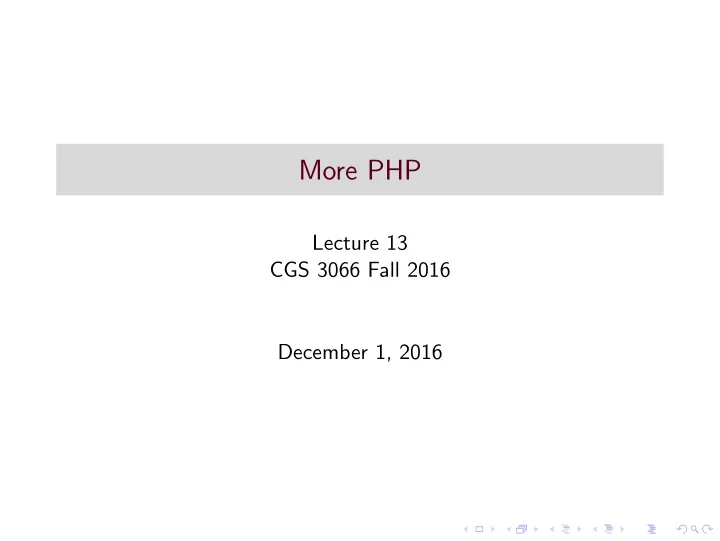

More PHP Lecture 13 CGS 3066 Fall 2016 December 1, 2016
Multi Dimensional Arrays ◮ A multidimensional array is an array containing one or more arrays. ◮ PHP understands multidimensional arrays that are two, three, four, five, or more levels deep. ◮ However, arrays more than three levels deep are hard to manage for most people. ◮ An n-dimensional array needs n indices to access an element.
Date and Time ◮ The PHP date() function formats a timestamp to a more readable date and time. ◮ Syntax: date(format,timestamp); ◮ The required format parameter of the date() function specifies how to format the date (or time). Here are some characters that are commonly used for dates: ◮ d - Represents the day of the month (01 to 31) ◮ m - Represents a month (01 to 12) ◮ Y - Represents a year (in four digits) ◮ l (lowercase ’L’) - Represents the day of the week
Creating a Date ◮ There are a few different ways to create a date. ◮ The mktime() function returns the Unix timestamp for a date. ◮ The Unix timestamp contains the number of seconds between the Unix Epoch (January 1 1970 00:00:00 GMT) and the time specified. ◮ The PHP strtotime() function is used to convert a human readable string to a Unix time.
Cookies ◮ A cookie is often used to identify a user. ◮ A cookie is a small file that the server embeds on the user’s computer. ◮ Each time the same computer requests a page with a browser, it will send the cookie too. ◮ With PHP, you can both create and retrieve cookie values.
Creating/Retrieving Cookies ◮ A cookie is created with the setcookie() function. ◮ Syntax: setcookie(name, value, expire, path, domain, secure, httponly); ◮ Only the name parameter is required. All other parameters are optional. ◮ The setcookie() function must appear BEFORE the < html > tag. ◮ We can then retrieve the value of the cookie using the global variable $ COOKIE. ◮ We can also use the isset() function to find out if the cookie is set.
Modifying/ Deleting Cookies ◮ The value of the cookie is automatically URLencoded when sending the cookie, and automatically decoded when received (to prevent URLencoding, use setrawcookie() instead). ◮ To modify a cookie, just set (again) the cookie using the setcookie() function. ◮ To delete a cookie, use the setcookie() function with an expiration date in the past.
AJAX ◮ AJAX = Asynchronous JavaScript and XML. ◮ AJAX is a technique for creating fast and dynamic web pages. ◮ AJAX allows web pages to be updated asynchronously by exchanging small amounts of data with the server behind the scenes. This means that it is possible to update parts of a web page, without reloading the whole page. ◮ Classic web pages, (which do not use AJAX) must reload the entire page if the content should change. ◮ Examples of applications using AJAX: Google Maps, Gmail, Youtube, and Facebook tabs.
Recommend
More recommend